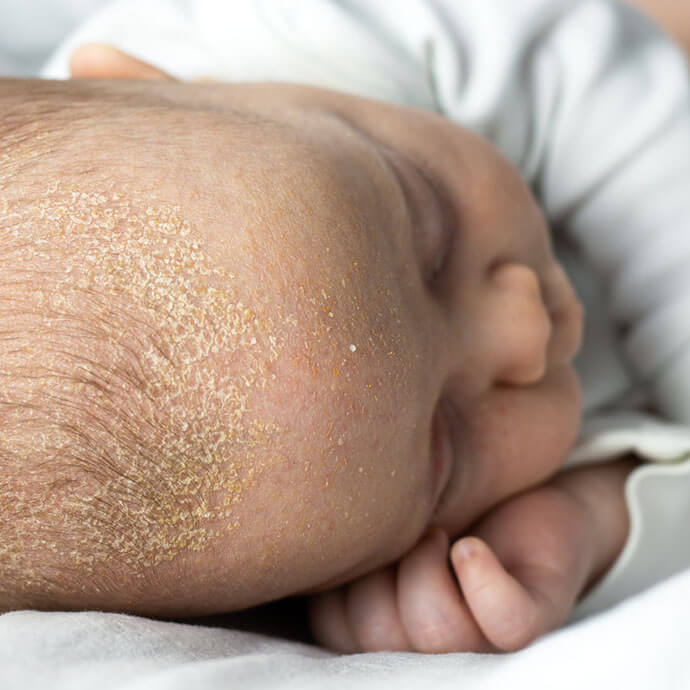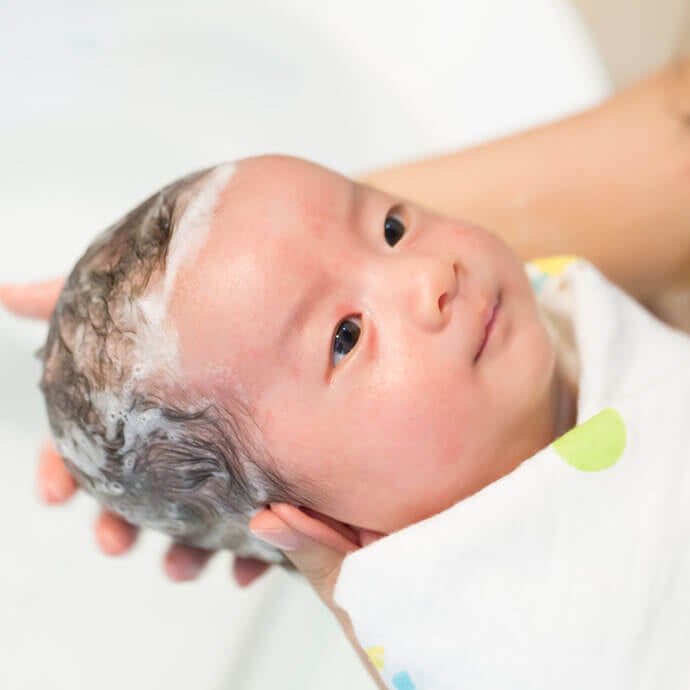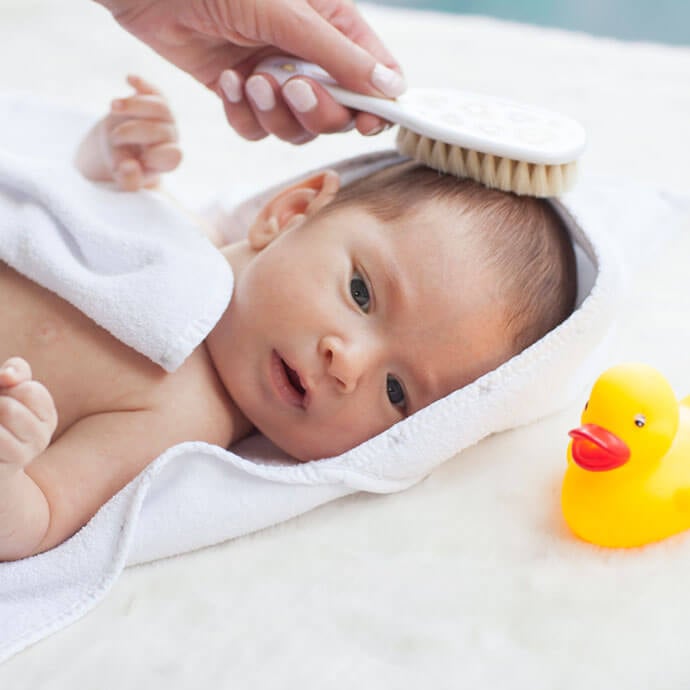What is cradle cap?
Newborn babies sometimes suffer from crusty or oily, scaly patches on the scalp, called cradle cap. It’s not painful or itchy but can cause thick white or yellow scales that are unsightly and tricky to remove.
“This is a condition known medically as seborrhoeic dermatitis, also known more commonly as cradle cap and it displays as yellow or white scaly patches on your baby’s scalp,” says Midwife Anneke.
“Other areas of the body can sometimes be affected, including the eyebrows, the back of the ears, around the nose, and sometimes your baby’s armpits and nappy area too.”
Is cradle cap contagious?
You can relax! Babies can’t ‘catch’ cradle cap from another child, or pass it on. It’s not caused by bad hygiene either.
What are the causes of cradle cap?
“We don’t really understand what causes cradle cap,” explains Anneke, “and we don’t know why some babies seem to be badly affected, while others barely have it or escape it altogether.
We think that it could be down to changes in your baby’s hormones, which have an effect on the glands that produce oil in your baby’s skin.”
When do babies get cradle cap and how long does it last for?
Usually, this condition starts at about four or five weeks after your little one is born.
The condition usually disappears after a few months; some babies will have it up to around their first birthday.

What does cradle cap look like?
“Typically, your baby’s head will show some small scales or flakes.,” says Anneke. “These may be individual flakes with healthy skin between them, or the patches may join up and affect a larger portion of your baby’s head.
If your baby was born with plenty of hair it may not be too noticeable – you may think it’s dandruff. However, if your baby has little to no hair, it can be quite obvious.”
The signs and symptoms of cradle cap are:
When checking your baby’s head for cradle, look for:
- Flaky, greasy, sometimes yellow crusts appear on your baby's scalp and sometimes other areas such as their eyebrows, cheeks, ears, armpits and the nappy area.
- The crusts can be dry and flaky. They may also make your baby’s skin look red and inflamed.
- The condition is not painful or itchy and shouldn’t bother your baby.
- It is harmless and doesn’t distress your baby but can look uncomfortable. Sometimes the crusts may flake off, leaving behind a red inflamed patch.
- Sometimes hair comes out with the flakes but don’t worry - it soon grows back.

How to treat cradle cap
If you’re looking at how to ‘get rid’ of your baby’s cradle cap, you can try the following:
Wash their hair gently
When bathing your baby, wash their hair gently with a special baby-friendly shampoo. Always rinse well.

Softly brush their hair
Use a very soft-bristled baby hairbrush on the scalp to gently remove loose flakes.
Try using coconut oil
Use a natural oil (coconut, sweet almond or grapeseed oil are suitable) or a special cradle cap oil on the scalp. It’s always best to do a skin test patch first by massaging in a drop of the oil on your baby’s ankle and leaving it for 24 hours, to see if irritation occurs. Gently massage the affected area of the head with a small amount of the oil. This will also help loosen the flakes.
Go see a pharmacist
In some cases, your pharmacist may suggest a cream or shampoo suitable for the age of your baby to put on the scalp.
How can you prevent cradle cap?
“It’s not really very easy to prevent cradle cap, as we don’t know why some babies have it. ,” explains Anneke.
“However, if you’re wondering how to prevent a recurrence, there are some newborn baby skin care methods you can use.”
Anneke’s top tips for preventing cradle cap
- Use an emollient like baby oil, sunflower or grapeseed oil. Never use peanut oil due to allergy risks.
- Never pick or scratch at the scales.
- Give your baby a gentle head massage (always avoid pushing on the fontanelle, the soft part of your baby’s head).
- Brush hair very gently.
- As it’s believed that stress can worsen skin conditions, try to ensure your baby is well rested and not agitated.
When should I see the doctor about cradle cap?
“Most of the time, parents can help improve cradle cap at home.,” says Anneke. However, there are times when things get out of hand and you need to visit your Health Visitor or GP, especially if your baby has scratched the scalp and it becomes infected. They may need to prescribe an antibiotic, or a corticosteroid lotion or cream for a short time.”
You should consult a health professional if:
- Cradle cap spreads over your baby's body.
- Any of the crusts start to bleed or leak fluid.
- If you can see red, swollen areas that seem inflamed or infected.
- If you suspect that your baby has infantile eczema or scabies instead of cradle cap, visit your doctor for a proper diagnosis.
Always at hand with expert advice
From nappy rash to dry skin to cradle cap, there’s a lot to learn about the delicate skin of a newborn baby. Don’t get overwhelmed – our newborn skin care advice can help.

 your parenting partner
your parenting partner